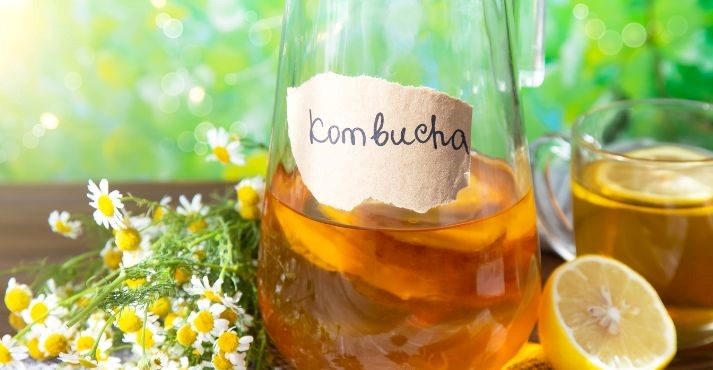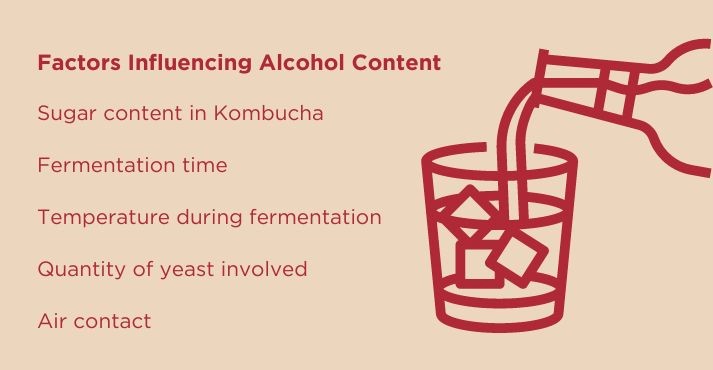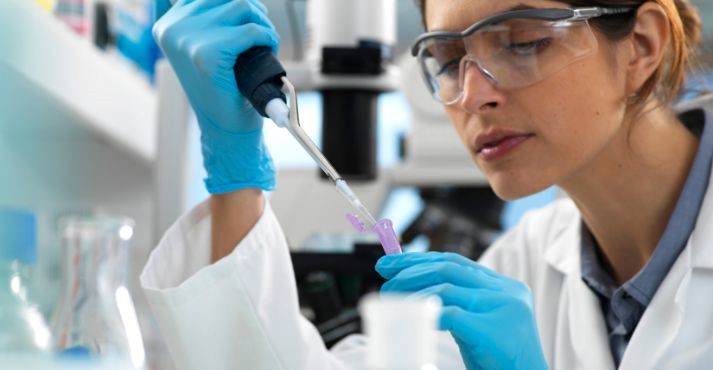Although the history of kombucha dates back thousands of years, it has become increasingly popular today.
Beer industry trends are showcasing consumer preferences towards healthier drinks and alternatives. Kombucha has unique flavor and characteristics and probiotic bacteria, making it a healthier option.
But do you know how much alcohol is in kombucha? Kombucha is not traditionally considered alcoholic, but it can contain trace amounts of alcohol.
Understanding Kombucha

Kombucha is an ancient food dating back to as early as 220 B.C. It is a fermented drink with tea, sugar, bacteria, and yeast. To make the drink, bacteria, and yeast must first grow together to form a culture. The culture is added to the sugar and tea. Then, the mix is allowed to ferment.
During Kombucha fermentation, sucrose is hydrolyzed by yeast cells into fructose and glucose, which are then metabolized to ethanol.
The ethanol is then oxidized by acetic acid bacteria (AABhe) to produce acetic acid, which is responsible for the pH reduction and contributes to Kombucha’s sour taste.
Regular kombucha contains acids that may offer some benefits, such as:
- Boosting the activity of antioxidants
- Enhancing digestion
- Increasing the nutritional value of food
Kombucha is rich in probiotics, which can help keep the gut flora healthy and functioning, decrease inflammation, and support the immune system. Kombucha also contains antioxidants, can kill harmful bacteria, and may help fight several diseases.
Studies suggest that kombucha has antimicrobial properties, mainly when made from green tea. This means it may help prevent the growth of harmful fungi and bacteria, such as Candida and Staphylococcus epidermidis, which can cause severe infections if they enter the bloodstream.
So, is there alcohol in kombucha? Let’s explore.
How Much Alcohol is in Kombucha?
The alcohol content of kombucha is around 0.5% ABV. These trace levels are a natural byproduct of the fermentation process. The longer the kombucha ferments as part of the food preservation, the more potential it has to contain/increase those trace amounts of alcohol.
It makes Kombucha non-alcoholic, as a drink is only classified as alcoholic if it contains more than 1.2% ABV.
Alcohol in Commercial Kombucha
The alcohol content in commercial Kombucha is regulated and typically kept below 0.5% ABV (alcohol by volume) to comply with legal limits for non-alcoholic beverages. This is achieved through controlled fermentation and filtration processes.
Alcohol in Homemade Kombucha
The alcohol in kombucha at home can vary but is generally higher than in commercial varieties. Factors like fermentation time and conditions impact alcohol levels, and some home-brewed batches may exceed the 0.5% ABV threshold, resembling a low-alcohol beverage, and contain alcohol ranging between 1% and 2.5%.
Factors Influencing Alcohol Content

Several factors influence alcohol content in beverages, including fermentation time, yeast strain, sugar concentration, and temperature.
Longer fermentation, higher sugar levels, and certain yeast strains contribute to increased alcohol content. Monitoring these factors is essential in commercial and homemade settings to control the final alcohol concentration in beverages like Kombucha.
Let’s examine the key factors that influence the alcohol content in Kombucha.
1. Sugar Content in kombucha
The sugar in kombucha serves as food for yeast during fermentation. The sugar content in kombucha directly affects alcohol production during fermentation. Yeast in the kombucha culture metabolizes sugar, converting it into alcohol.
Higher sugar concentrations increase alcohol content as more sugar is converted into alcohol. Precise control of sugar levels is essential in crafting kombucha with desired characteristics, balancing sweetness and alcohol content.
Monitoring and adjusting sugar content allow brewers to manage the fermentation process and achieve the desired balance in the final beverage.
2. Fermentation Time
Extended fermentation allows yeast more time to convert sugars into alcohol. The longer the fermentation process, the higher the potential for elevated alcohol levels in the final kombucha product.
Extended exposure to fermentation conditions increases the likelihood of achieving higher alcohol content.
Controlling fermentation time is essential in achieving a balanced kombucha profile, as it determines the level of sweetness retained versus the extent of sugar conversion to alcohol.
Brewers carefully manage this aspect to produce kombucha with the desired flavor, enthusiasm, and alcohol content.
3. Temperature during fermentation
Warmer temperatures accelerate the fermentation process, potentially leading to higher alcohol content in kombucha. Higher temperatures promote faster fermentation, leading to increased alcohol production.
Controlling the fermentation temperature allows brewers to balance alcohol content and other flavor characteristics. Precise temperature control is essential to achieve the desired kombucha profile, ensuring sweetness, acidity, and alcohol content in the final beverage.
4. Quantity of Yeast involved
The amount of yeast introduced influences fermentation speed and efficiency. More yeast can expedite the conversion of sugars to alcohol, impacting the overall alcohol content in kombucha.
Brewers carefully adjust the yeast quantity to control the pace of fermentation and achieve the desired balance between sweetness and alcohol content in the final kombucha product, influencing flavor profile and characteristics.
5. Air Contact
Oxygen may introduce aerobic bacteria that consume alcohol. While minimal air contact is generally preferred, excessive exposure might affect fermentation dynamics, potentially influencing the alcohol levels in the finished kombucha.
Inadequate protection against oxygen exposure may lead to incomplete fermentation, affecting alcohol levels.
Testing Alcohol Content in Kombucha

Kombucha is classified as a functional food because of its potentially beneficial effect. While kombucha does contain antioxidants and probiotics, there are also a few risks associated with Kombucha.
Therefore, kombucha alcohol percentage must be tested by the food and beverage producers or at home.
Excessive acetic acid may hinder bacteria growth if the pH exceeds 4.2 in fermentation. Too much acid in the product can have adverse health effects.
For testing alcohol content in Kombucha, you can use the following ways.
- Hydrometers: A hydrometer measures specific gravity to estimate alcohol content. Initial and final readings help calculate the change, indicating alcohol production during fermentation.
- Alcohol Testing Kits: These kits employ enzymatic reactions or chromatography to detect alcohol levels. They provide accurate measurements and are convenient for both commercial and homebrewed Kombucha.
Moreover, whether homebrewed or produced commercially, you must follow food safety practices that help prevent biological hazards.
How Much Alcohol is in Hard Kombucha?
Hard Kombucha is a fermented beverage with an elevated alcohol content compared to traditional Kombucha. Hard Kombucha has a unique flavor – fizzy, zingy, tart, and mildly sweet; it’s one of the tastiest drinks.
It undergoes an extended fermentation process, allowing the yeast to convert more sugar into alcohol. The result is a beverage with an alcohol by volume (ABV) ranging from around 4% or higher, providing a more alcoholic alternative to regular Kombucha.
The alcohol content in hard Kombucha typically falls within the 4% to 10% ABV range. The alcohol content of hard kombuchas is similar to that of beer, hard seltzers, and wine.
This is notably higher than the alcohol content in non-alcoholic or commercially available Kombucha, which usually aims to stay below 0.5% ABV.
Safety Concerns Related to Kombucha
Consuming kombucha presents health and safety concerns primarily due to its fermentation process. Home-brewed kombucha may risk contamination from harmful bacteria or mold if not prepared with proper hygiene practices.
Additionally, kombucha contains trace amounts of alcohol, which could pose risks for individuals with alcohol sensitivities or those avoiding alcohol. Excessive consumption may lead to digestive discomfort or exacerbate underlying health conditions.
While commercially produced kombucha undergoes stricter quality control measures, there’s still a potential for allergic reactions or adverse effects, especially if consumed beyond recommended intake levels. As with any food or beverage, moderation and caution are key for safe kombucha consumption.
How Much Alcohol is in Kombucha? (FAQs)
Will drinking kombucha get you drunk?
Drinking kombucha typically contains trace amounts of alcohol, usually less than 0.5% alcohol by volume (ABV), which is similar to the alcohol content in non-alcoholic beer. While it’s highly unlikely to get drunk from kombucha, individuals sensitive to alcohol should consume it in moderation.
Is kombucha drink halal?
Kombucha is generally halal, made from tea, sugar, and a culture of bacteria and yeast (SCOBY). However, it’s essential to ensure that no non-halal ingredients are added during brewing, as alcohol is produced as a by-product in the tea’s fermentation process.
Is kombucha a strong drink?
No, Kombucha is not typically considered a strong drink. It usually contains low levels of alcohol, around 0.5% ABV or less, similar to many non-alcoholic beverages. However, hard Kombucha varieties with higher alcohol content are available.
Conclusion
Kombucha has many potential health benefits and is considered one of the healthiest alcohol drinks. Kombucha is a fermented drink, and the ingredients work together to create probiotics, the bacteria needed to keep your gut healthy.
Now that you know how much alcohol is in kombucha, it is important to start drinking small quantities to see how your body reacts to the beverage.





























